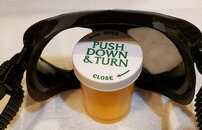- Messages
- 7,659
- Reaction score
- 4,720
- # of dives
- 200 - 499
Update:
A pourable cream of 1:1 (by weight) tooth paste : ammonium bicarbonate and sufficient water is now 'seasoning' one half of a brand new mask, right out of the box. Being done in the open air so that all hard plastic parts are not affected. -let you know the results in three days...
In addition:
A private communication with @couv was most interesting. He suggested that a lot of the confusion comes from the fact that some masks are easier to season than others. His suggestion was to generate a true "Mask from Hell" for testing. I post this publicly as proper crediting of ideas is key in real scientific research.
Yes, a 'standard' MFH would be useful for testing antifog treatments. And, as couv suggested, renewable. Most interesting.
(PDF) Rapid Silylation of a Glass Surface: Choice of Reagent and Effect of Experimental Parameters on Hydrophobicity
The above link contains the best reference that I can find for silylation of glass surfaces. A fully silylated lens should fog miserably. An interesting point in this paper is that the optimum temperature for conversion is 220-350 degrees Centigrade (430-660 F). Possibly, true MFH's are formed in overheated molds???
A pourable cream of 1:1 (by weight) tooth paste : ammonium bicarbonate and sufficient water is now 'seasoning' one half of a brand new mask, right out of the box. Being done in the open air so that all hard plastic parts are not affected. -let you know the results in three days...
In addition:
A private communication with @couv was most interesting. He suggested that a lot of the confusion comes from the fact that some masks are easier to season than others. His suggestion was to generate a true "Mask from Hell" for testing. I post this publicly as proper crediting of ideas is key in real scientific research.
Yes, a 'standard' MFH would be useful for testing antifog treatments. And, as couv suggested, renewable. Most interesting.
(PDF) Rapid Silylation of a Glass Surface: Choice of Reagent and Effect of Experimental Parameters on Hydrophobicity
The above link contains the best reference that I can find for silylation of glass surfaces. A fully silylated lens should fog miserably. An interesting point in this paper is that the optimum temperature for conversion is 220-350 degrees Centigrade (430-660 F). Possibly, true MFH's are formed in overheated molds???




